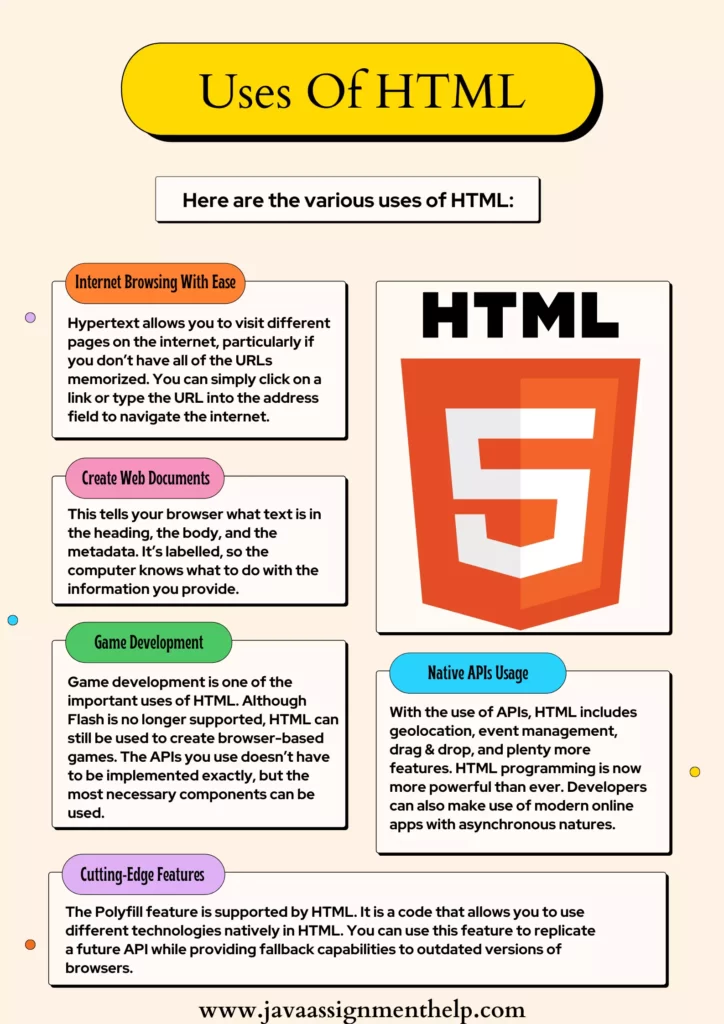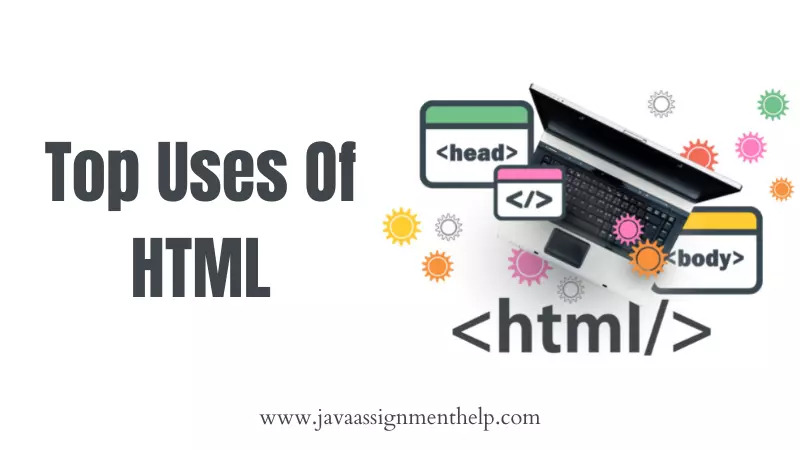Are you a beginner in web development and want to know the various uses of HTML? Stay here with us, as in this blog, we are going to provide detailed information on the top uses of HTML.
HTML is one of the most popular web development technologies. It is a markup language that is used to create web pages and web applications. HTML is used in combination with CSS and JavaScript to create attractive and responsive web pages.
HTML provides several different elements, like <head>, <body>, <p>, <img>, <a>, etc, that act as building blocks for a website. Browsers use these HTML elements to interpret and represent the content on the web page.
In case you need any help with HTML, or web designing assignment help, you can discuss your requirements with our experts and get instant help.
Let’s look at the overview of HTML before moving towards the uses of HTML.
Overview Of HTML
HTML (HyperText Markup Language) is the language that a web browser (such as Google Chrome, Safari, Firefox, or Microsoft Edge) understands and uses to render a webpage.
With the help of different elements, HTML determines how a web page looks and displays content. The Hypertext Markup Language (HTML) is a simple markup language for creating platform-independent hypertext documents.
HTML documents are SGML (Standard Generalized Markup Language) documents that have general semantics and can be used to represent data from a variety of disciplines.
HTML markup can be used to create hypertext mail, documentation, news, and hypermedia; menus of options; database query results; simple structured documents with in-lined graphics; and hypertext views of existing data sets.
Top Companies Using HTML
- Amazon
- YouTube
- Tencent
- Tmall
- Taobao
- Sohu
- Baidu.com
How Does HTML Work?
HTML is behind the structure of every page we use and view on the Internet. It uses tags to instruct the text on how to behave. Headings, page breaks, strong letters, paragraphs, italics, and many other things are added to a web page using HTML. To make a word appear italic, we place it between the tags <i>italic</i>. The initial tag specifies the beginning of the italic style word, and the closing tag(/) indicates where the italic text style should end. It is the base for almost every online page.
HTML Program to Display “Hello HTML”
<!DOCTYPE> <html> <head> <title>Program to display hello HTML</title> </head> <body> <h1>Hello HTML</h1> <p>Hello HTML in paragraph</p> </body> </html>
Output
What Type Of Language Is HTML?
HTML is a markup language. It specifies the purpose of data on the webpage by marking up data within HTML tags. The HTML describes the data to the browser. After that, the web browser examines the HTML code, which tells it which parts are paragraphs, which sections are headings, which parts are links, and so on. Web browsers then display the web page according to this data.
Main Uses Of HTML Language
Here are the various uses of HTML:
Internet Browsing With Ease
Hypertext allows you to visit different pages on the internet, particularly if you don’t have all of the URLs memorized. You can simply click on a link or type the URL into the address field to navigate the internet.
Hypertext is essential to lead users throughout your website and act as a gateway so that they are aware that different pages exist and they can navigate between them.
Without using hypertext, it is difficult for users to detect if there are any additional web pages on the website.
Cutting-Edge Features
The Polyfill feature is supported by HTML. It is a code that allows you to use different technologies natively in HTML. You can use this feature to replicate a future API while providing fallback capabilities to outdated versions of browsers.
You can customize polyfill libraries to meet your specific requirements and perform things that no one else has done before. These cutting-edge features of HTML are the reasons behind the so many uses of HTML.
Create Web Documents
A web page is simply a web document where you can write the material you want the user to see and then wrap it in code that instructs the machine on how to format the whole thing.
This tells your browser what text is in the heading, the body, and the metadata. It’s labelled, so the computer knows what to do with the information you provide.

Data Entry
You have all of the APIs you’ll need to do any data entry tasks. As a developer, you just need to add tags to the relevant fields, such as text and data formats.
You may even provide on-screen keyboards and validation, ensuring a smooth and pleasant experience for the user.
Game Development.
Game development is one of the important uses of HTML. Although Flash is no longer supported, HTML can still be used to create browser-based games. The APIs you use doesn’t have to be implemented exactly, but the most necessary components can be used.
At the same time, the rest of the features are removed, resulting in a lighter experience. Thanks to HTML5’s advancements, HTML is swiftly becoming one of the most popular game programming languages.
Offline Storage
What if some of your users aren’t online? With the help of application cache methods found in the most recent version of HTML, you can still make your applications operate. The application cache is responsible for a variety of offline capabilities and includes a variety of components, including API calls that require updates.
Through the manifest file, you may control what the browser does with its offline use and even the resources it uses.
Native APIs Usage
API stands for “application programming interface”. It is a way for two different apps to communicate with one another. With the use of APIs, HTML includes geolocation, event management, drag & drop, and plenty more features.
HTML programming is now more powerful than ever. Developers can also make use of modern online apps with asynchronous natures.
Store Things On The Client-Side
IndexDB and Localstorage make storing files on the client-side simpler and more efficient. These have their own set of powerful features.
Localstorage supports the setItem, getItem, and removeItem methods, as well as string-based hash table storage. IndexDB comes with even more storage, which you can increase with the user’s permission.
User Friendly
HTML is renowned for being user-friendly, even for beginners, unlike other programming languages. So, this is also one of the main uses of HTML. There are semantic components in HTML that describe the content type they have.
For example, HTML common tags such as header, footer, main, summary, and time are self-descriptive.
Accessible Rich Internet Applications
The use of HTML5 semantic tags makes the website search engine and screen reader-friendly.
When semantic tags are used correctly, visually impaired people can obtain information from web pages using screen readers.

Why Is It Useful To Use HTML?
HTML is extremely useful to use. It is a markup language that describes the structure of Web pages. HTML is the most widely used markup language for building websites. HTML elements or tags act as building blocks for web pages. This means that if you wish to create a web page, HTML is used to create the structure of that web page. HTML works the same in a web page as the bones in a human body. Here are some other things that tell why HTML is useful to use:
- Above 90% of all websites use HTML.
- According to Statista, HTML is the second most popular language developers use after Java.
- Almost every browser supports HTML.
Programmers with HTML skills are highly demanded and paid. According to ZipRecruiter, HTML developers annually earn $94,491 on average.
Conclusion
In this blog, we have told all the important uses of HTML. Websites or web-based documents use HTML as their default language. It helps a browser to understand the structure and style of a document or file for internet reading.
It allows you to embed audio, spreadsheets, videos, and other apps into your web pages. It also uses hypertext to make browsing within pages and across websites easier.
Website designers can also utilise HTML to create forms for making bookings, ordering things, and finding information. Hopefully, now you have a clear picture of all the important uses of HTML.
Moreover, if you need node js assignment help or reactjs assignment help, our experts are ready to help you at an affordable price.
Frequently Asked Questions
Is HTML easy to learn?
HTML is one of the easiest web programming languages to learn. So, if you want to learn web programming and are scared about the difficulty of learning HTML, you don’t need to worry. HTML is super easy to learn.
Why do developers use HTML?
Developers use HTML to provide the structure to the content of the website. HTML basically provides the skeleton of web pages. It helps developers organize the various web elements like text, images, videos, etc. It is usually the first language learned by web developers.

